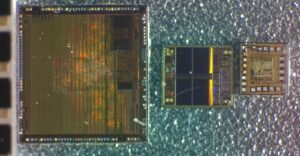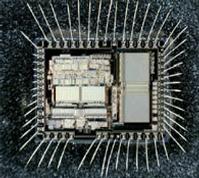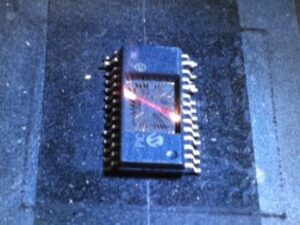 Attack MCU MSP430G2452IPW14R Heximal
Attack MCU MSP430G2452IPW14R Heximal
Attack MCU MSP430G2452IPW14R Hexadecimal: Firmware Extraction and Reverse Engineering
The MSP430G2452IPW14R is a low-power microcontroller from Texas Instruments, widely used in embedded systems. However, its flash memory and EEPROM memory can be targeted for firmware extraction, reverse engineering, or cloning. This article explores methods to crack, decode, and dump the hexadecimal data from this MCU.

MSP430G2452IPW14R è un microcontrollore a bassa potenza di Texas Instruments, ampiamente utilizzato nei sistemi embedded. Tuttavia, la sua memoria flash e la sua memoria EEPROM possono essere prese di mira per l’estrazione del firmware, il reverse engineering o la clonazione. Questo articolo esplora i metodi per crackare, decodificare e scaricare i dati esadecimali da questa MCU.
Dumping Firmware from Flash Memory
To extract the program file from the MSP430G2452IPW14R, attackers often use JTAG or SBW (Spy-Bi-Wire) interfaces. By connecting a programmer like the MSP-FET or a universal flash tool, the binary code can be read out and saved as a hex file. Some advanced techniques involve power glitching or timing attacks to bypass security fuses.
Decrypting and Reverse Engineering
Once the heximal data is dumped, the next step is decoding the firmware. Since the MSP430 uses a 16-bit RISC architecture, disassemblers like IDA Pro or Ghidra can help reverse engineer the source code. If the firmware is encrypted, brute-force attacks or side-channel analysis may be required to crack the protection.

MSP430G2452IPW14R से प्रोग्राम फ़ाइल को निकालने के लिए, हमलावर अक्सर JTAG या SBW (स्पाई-बाय-वायर) इंटरफेस का उपयोग करते हैं। MSP-FET या यूनिवर्सल फ्लैश टूल जैसे प्रोग्रामर को कनेक्ट करके, बाइनरी कोड को पढ़ा जा सकता है और हेक्स फ़ाइल के रूप में सहेजा जा सकता है। कुछ उन्नत तकनीकों में सुरक्षा फ़्यूज़ को बायपास करने के लिए पावर ग्लिचिंग या टाइमिंग अटैक शामिल हैं।
Cloning and Firmware Restoration
After successful decryption, the binary archive can be copied to another MSP430 chip, enabling cloning of the original device. Some attackers decapsulate the MCU to perform microprobing on the flash memory for direct data extraction.
Security Countermeasures
To prevent such attacks, developers should:
Enable read-out protection bits
Use encrypted firmware updates
Implement secure bootloaders
Despite these measures, skilled attackers can still break the security using advanced reverse engineering techniques. Therefore, protecting sensitive hexadecimal firmware remains a critical challenge in embedded security.
By understanding these attack vectors, engineers can better defend against firmware theft and unauthorized cloning of the MSP430G2452IPW14R.

Attack MCU MSP430G2452IPW14R flash memory and extract heximal from Microcontroller MSP430G2452, the status of Microprocessor will be reset from locked to open one after get access to the databus
Attack MCU MSP430G2452IPW14R flash memory and extract heximal from Microcontroller MSP430G2452, the status of Microprocessor will be reset from locked to open one after get access to the databus;
FEATURES
Low Supply Voltage Range: 1.8 V to 3.6 V
Ultra-Low Power Consumption
– Active Mode: 220 µA at 1 MHz, 2.2 V
– Standby Mode: 0.5 µA
– Off Mode (RAM Retention): 0.1 µA
Five Power-Saving Modes
Ultra-Fast Wake-Up From Standby Mode in Less Than 1 µs
16-Bit RISC Architecture, 62.5-ns Instruction Cycle Time Basic Clock Module Configurations
– Internal Frequencies up to 16 MHz With
Four Calibrated Frequencies
– Internal Very-Low-Power Low-Frequency (LF) Oscillator
– 32-kHz Crystal
– External Digital Clock Source
One 16-Bit Timer_A With Three Capture/Compare Registers

След като шестнадесетичните данни бъдат изхвърлени, следващата стъпка е декодирането на фърмуера. Тъй като MSP430 използва 16-битова RISC архитектура, дизасемблери като IDA Pro или Ghidra могат да помогнат за обратното проектиране на изходния код. Ако фърмуерът е криптиран, може да са необходими груби атаки или анализ на страничния канал, за да се пробие защитата.
Up to 16 Touch-Sense Enabled I/O Pins
Universal Serial Interface (USI) Supporting SPI and I2C
10-Bit 200-ksps Analog-to-Digital (A/D)
Converter With Internal Reference, Sample-and-Hold, and Autoscan (MSP430G2x52 Only)
On-Chip Comparator for Analog
Brownout Detector Serial Onboard Programming,
No External Programming Voltage Needed,
Programmable Code Protection by Security Fuse
On-Chip Emulation Logic With Spy-Bi-Wire Interface
Family Members are Summarized in Table 1 Package Options
– TSSOP: 14 Pin, 20 Pin
– PDIP: 20 Pin
– QFN: 16 Pin
For Complete Module Descriptions, See the MSP430x2xx Family User’s Guide (SLAU144)